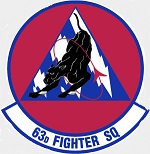Hobby Master HA3813 USAF General Dynamics F-16DG Viper Fighter - 63rd Fighter Squadron "Panthers", 56th Fighter Wing, "Foxbat Killer", December 27th, 1992 [Low-Vis Scheme] (1:72 Scale)
"Obsolete weapons do not deter."
- British Prime Minister Margaret Thatcher
 Even at the ripe old age of 20, the F-16 Falcon remains a fast and potent favorite among fighter pilots, and one of the best fighters in its class. Designed originally as a no-frills, single-engine "hot rod", the addition of improved radar and weaponry have made the Falcon a super, lightweight jet. Used mainly as a bomber, the Fighting Falcon can also turn-and-burn with unbridled fury when provoked. It is also one of the first operational fly-by-wire aircraft; its flight controls being electronically operated and computer controlled. A 20mm cannon, Maverick missiles, and laser-guided bombs make the F-16 a potent multi-role fighter. However, it's light weight, speed and agility make it the choice of the US Air Force's Thunderbirds aerobatic team.
Even at the ripe old age of 20, the F-16 Falcon remains a fast and potent favorite among fighter pilots, and one of the best fighters in its class. Designed originally as a no-frills, single-engine "hot rod", the addition of improved radar and weaponry have made the Falcon a super, lightweight jet. Used mainly as a bomber, the Fighting Falcon can also turn-and-burn with unbridled fury when provoked. It is also one of the first operational fly-by-wire aircraft; its flight controls being electronically operated and computer controlled. A 20mm cannon, Maverick missiles, and laser-guided bombs make the F-16 a potent multi-role fighter. However, it's light weight, speed and agility make it the choice of the US Air Force's Thunderbirds aerobatic team.
The F-16C (single seat) and F-16D (two seat) variants entered production in 1984. The first C/D version was the Block 25 with improved cockpit avionics and radar which added all-weather capability with beyond-visual-range (BVR) AIM-7 and AIM-120 air-air missiles. Block 30/32, 40/42, and 50/52 were later C/D versions. The F-16C/D had a unit cost of US$18.8 million (1998). Operational cost per flight hour has been estimated at $7,000 to $22,470 or $24,000, depending on calculation method.
Pictured here is a gorgeous 1:72 scale diecast replica of a USAF General Dynamics F-16DG Viper fighter that was attached to the 63rd Fighter Squadron, 56th Fighter Wing, on December 27th, 1992.
Sold Out!
Dimensions:
Wingspan: 7-inches
Length: 8-inches
Release Date: March 2013
 Historical Account: "Panthers" - On November 1st, 1991, the host 56th Tactical Training Wing at MacDill implemented the Objective organization plan, and the subsequent re-designation of units led to the 63d becoming simply the 63d Fighter Squadron, and being assigned to the new 56th Operations Group. The end of the Cold War led to the BRAC commissions, and the downsizing of the Air Force to a smaller organization. As a result, it was decided first to close MacDill AFB, although under political pressure later it was realigned to a new mission.
Historical Account: "Panthers" - On November 1st, 1991, the host 56th Tactical Training Wing at MacDill implemented the Objective organization plan, and the subsequent re-designation of units led to the 63d becoming simply the 63d Fighter Squadron, and being assigned to the new 56th Operations Group. The end of the Cold War led to the BRAC commissions, and the downsizing of the Air Force to a smaller organization. As a result, it was decided first to close MacDill AFB, although under political pressure later it was realigned to a new mission.
Like its two sister squadrons, the 61st and 62d FS, the 63d Fighter Squadron was reassigned to Luke AFB, Arizona, but instead of getting block 25s the squadron took over block 42 F-16Cs. The 63d was activated at Luke AFB on February 25th, 1993. The move was one of the starts to the process of making Luke AFB the main F-16 Replacement Training Unit.
On January 14th, 2008, the 63d Fighter Squadron started a course that caught a few aviation headlines. They began training pilots selected to fly the F-22 Raptor, pilots who have never flown a fighter before. Up to this point F-22 pilots were hand-picked from the existing fighter community. Once the training in the F-16 was completed, the student pilots were reassigned to the 43d Fighter Squadron at Tyndall AFB, Florida where they spent the next two years training with the F-22.
In February 2008, it was announced that the 63d FS was to be inactivated as a result of BRAC 2005 that Luke AFB give up twenty-five block 25 F-16s. Although the 63d FS flew the Block 42 it transferred its F-16s to the 61st FS, which did operate the block 25. The 61st, due to its seniority and historical heritage, would remain active.
On April 4th, 2009, the 63d graduated its last class of F-16 pilots at which time it continued the process to deactivate. Officially the squadron stood down on May 22nd, 2009, after 68 years of service.


